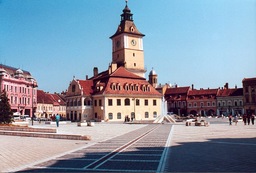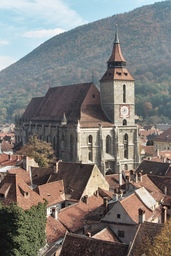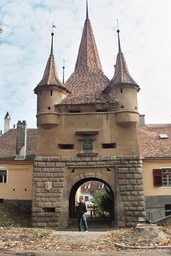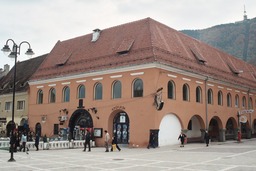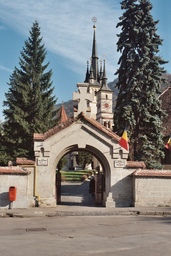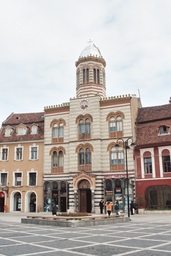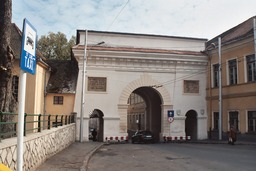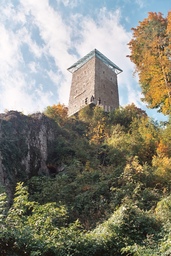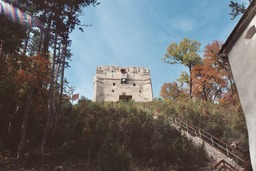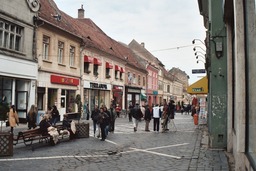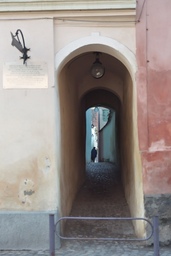|
Click to see larger pictures |
The Council Square
The Council Square (Piata Sfatului) is the heart of the old medieval Brasov. Lined with beautiful red-roofed merchant houses, the square is one of the finest in the country. In the center of the square lies the Council House, built in 1420. The building used to serve as Brasov's city hall; today it houses Brasov's Historical Museum. The exhibits tell the history of the Saxon guilds, who dominated Brasov during medieval times. On top of the building sits the Trumpeter's Tower which was once a watchtower for approaching barbarians before being incorporated into the building. Around the square you'll find some of the smaller landmarks captured by my other tips like the Renaissance style Hirscher House or Merchant's House (now the "Cerbul carpatin" restaurant), the beautiful entrance to the Orthodox cathedral or the museum dedicated to the Mureseanu family out of which came the first editor of Gazeta Transylvania, a political newspaper published in the 19th century. One of the square's corners is dominated by the town's most famous landmark, the Black Church. Piata Sfatului is a nice place to rest, and soak in the beautiful scenery. In the summer outdoor cafes line the square and the place is lively. Every late summer the "Golden Stag" (Cerbul de Aur) music festival takes place here.|
Click to see larger pictures |
The Black Church
The Black Church is Brasov's most prominent landmark and one of the finest examples of Gothic architecture in Romania. A true center of Transylvanian Protestantism, the church was built between 1383 and 1477. In 1689 the church was nearly destroyed by a great fire caused by the Austrian army that occupied Brasov. It was then that the church was named the Black Church from its blackened walls. The church has a beautiful collection of Turkish rugs from the 17C and 18C, one of the richest collection of its kind in all Europe. Through their rich colors and diverse motifs the carpets warm the severe interior. They were received as gifts from local merchants who returned from trips to the Ottoman lands. Another impressive feature is the church's organ, built by Buchholz of Berlin in 1839. In the summer you can listen to organ recitals, throughout July and August. The church is still used by German Lutherans today. There's a small admission fee to visit the interior. Address: Court J. Honterus 2|
Click to see larger pictures |
Ecaterina's Gate
Ecaterina's Gate is the only original city gate to survive from medieval times. In fact the fairy-tale looking tower which was built in 1559 is only a part of the original gate; documents talk about the existence of a wooden structure which was demolished in 1827. The four small corner turrets (also seen in other Transylvanian towns) symbolize the fact that the town had judicial autonomy, and the "right of sword" (ius gladii) which was the right to decide on capital punishment. Above the entrance the tower bears the city's coat of arms, a crown on a tree trunk. The gate was in the care of the taylors' guild.|
Click to see larger pictures |
The Hirscher House
This imposing house which borders the Council Square (Piata Sfatului) was built during 1541-1547 by Apollonia Hirscher, the widow of Brasov's mayor Lukas Hirscher. The house was a tribute to the city and its intended use was as a trade center for the merchants of Brasov. The house design in Renaissance style was modeled to resemble the merchandise halls from the old big cities of Eastern Europe. Because the first floor was the market for high-boots, the building was named "Podul Batusilor" (The High-Boots Bridge). Above the entrance you can see the Hirsher's coat of arms. Today the building is hosting a traditional restaurant, The Carpathian Stag (Cerbul carpatin). Address: Piata Sfatului, 14.|
Click to see larger pictures |
Saint Nicholas Church
Saint Nicholas Church is the oldest Orthodox church in Brasov and one of the oldest churches in Transylvania. The church was first built in wood in 1392 and replaced with a stone structure in 1495 by the Wallachian prince Neagoe Basarab who supported the Romanian community in Brasov. The church is a true architectural masterpiece with a mix of the Byzantine, Baroque and Gothic elements. The final construction was ready in 1594 and the church was then again altered in 1739 when it was extended, the clock tower was added and the interior was embellished. Like other medieval churches it is surrounded by protective walls with large wooden gates. Inside the pretty garden there is also a small old cemetery; beside the church is the First Romanian-language school (1495), now a museum. The church's treasury contains a large collection of icons, paintings and liturgical objects, many of them made by the famous handcraftsmen from Brasov. Address: Piata Unirii, 1|
Click to see larger pictures |
Romanian Orthodox Cathedral
Opposite the old town hall on the east side of the Council Square and hidden behind an archway lies the Romanian Orthodox Cathedral. Its portal which serves as the parish house faces the square trying to blend among the merchant's houses. The cathedral was built in Byzantine style in 1896 under the care of the archpriest Bartolomeu Baiulescu; the church was modeled after the Greek church in Viena. It is worth entering the church for the frescoes and the impressive decorations. Address: Piata Sfatului, 3.|
Click to see larger pictures |
The Schei Gate
During the Saxon rule of the 13th to 17th century Romanians were forbidden from owning property inside the fortress walls and such they settled outside the wall in the neibourhood named Schei. Romanians could only enter the town at certain times and had to pay a toll at the gate for the privilege of selling their produce inside the citadel. One of the remaining gates of the town is Schei Gate (Poarta Schei). The structure that we can see today was built in 1827 and replaced the old Schei Gate which was heavily damaged from fires. The gate looks like a triumphal arch with three openings. Above the small arches on both sides of the gate you can see inscriptions in Latin. Address: Str. Schei.|
Click to see larger pictures |
The Black Tower
Because Brasov and the surrounding region were repeatedly raided by the Turks and Tatars the town decided to fortify itself. In the 15th century the Saxons build a defence wall which was once 12 meters high and two meters thick and stretched for 3 km. They also erected seven bastions around the city, and the guarding of the bastions was entrusted to guilds. Parts of the walls still remain today and can be seen along the Dupa Ziduri Street (Dupa Ziduri means Behind the Walls). Of the original seven bastions a few survived, including the squared Black Tower which lies at the west of the old city wall. The tower built in 1494 now houses a museum, and they charge a small fee for seeing a museum but frankly there's not much to see inside. From the top you do get a nice view of the Black Church but you get almost the same view from the iron balcony surrounding the tower. Apparently the name comes from the tower being severely burnt in 1559 (it doesn't look black today). Address: Str. Dupa Ziduri.|
Click to see larger pictures |
The White Tower
The White Tower is another one of the seven bastions which were part of the town defensive walls in the 15th century. Because Brasov and the surrounding region were repeatedly raided by the Turks and Tatars the town decided to fortify itself. The Saxons build a defence wall which was once 12 meters high and 2 meters thick and stretched for 3 km. They also erected seven bastions around the city, and the guarding of the bastions was entrusted to guilds. Parts of the walls still remain today and can be seen along the Dupa Ziduri Street (Dupa Ziduri means Behind the Walls). The semicircular White Tower was also finished in 1494, like the Black Tower. The tower is located high up the hill and you'll have to climb some 200 steps up to it (serious exercise). Address: Str. Dupa Ziduri.|
Click to see larger pictures |
Republicii Street, Brasov pedestrian thoroughfare
Strada Republicii is Brasov's main thoroughfare, leading away from the Council Square towards Bdul Eroilor. No cars are allowed here which makes it a popular place for strolling. The street is lined with shops, cafes and restaurants and it's crowded but nice, especially in the summer.|
Click to see larger pictures |
